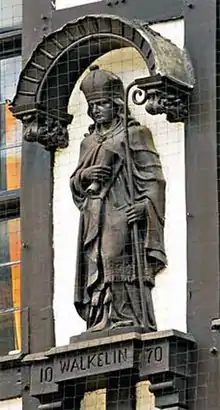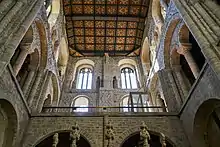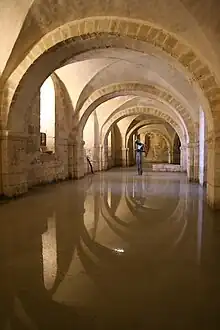Walkelin | |
|---|---|
| Bishop of Winchester | |
 Statue of Walkelin, in Winchester | |
| Appointed | 23 May 1070 |
| Term ended | 3 January 1098 |
| Predecessor | Stigand |
| Successor | William Giffard |
| Orders | |
| Consecration | 30 May 1070 |
| Personal details | |
| Died | 3 January 1098 |
| Buried | Winchester Cathedral |
| Denomination | Catholic |
Walkelin[lower-alpha 1] (d. 1098) was the first Norman Bishop of Winchester. He began the construction of the current Winchester Cathedral, and tried to replace the adjoined monastery with a chapter of canons.
Life
Early career
Walkelin was possibly related to William the Conqueror, whom he served as a royal chaplain.[1][2] Before the Norman Conquest, he had probably been a canon at Rouen Cathedral.[1][3]
In April 1070, Stigand was deposed as Bishop of Winchester by papal legates at the Council of Winchester (1070), having-been-excommunicated by five different popes for holding the post of Archbishop of Canterbury at the same time, being a pluralist.[1][4] Walkelin was nominated to be Bishop on 23 May 1070; he was consecrated on 30 May by the papal legate Ermenfrid.[1][2][5]
Bishop of Winchester
Reform
Walkelin aimed to replace the monks in the Cathedral by canons. This would have helped him to fund his episcopal household and any future construction projects. Walkelin gained royal approval for this change. However, Lanfranc, who had just been consecrated as Archbishop of Canterbury by a selection of bishops including Walkelin himself, opposed the change, and successfully blocked it.[1][6][7]
To raise funds in a different way, Walkelin is said to have divided the see's assets between himself and the convent and to have appropriated some of the monks' land and patronages. The fact that his brother Simeon was Prior of Winchester allowed this to take place.[1]
On the other hand, Walkelin is said to have improved the Cathedral and monastery "in devotion, in the number of its monks and in the buildings of the house".[lower-alpha 2][8]
Construction


Walkelin began work on a new cathedral church, the current Winchester Cathedral, in 1079, to replace the Old Minster. Walkelin's project was of a monumental scale, with a length of almost 180 yards, almost unrivalled by other contemporaneous projects. The monks are reported to have moved into the new building in 1093, along with St Swithun's feretory. The demolition of the Old Minster began shortly after this move. It is most likely that the initial construction was completed under William Giffard in around 1122.[1][8]
There is a story, related as such in the Winchester Annals, about Walkelin gathering timber for the construction of the cathedral church. In 1086, William I reportedly granted Walkelin as much from a certain wood as his carpenters could take in three/four days. The bishop gathered lots of carpenters and cut the whole wood down within the allotted time. Upon discovering this, the king was enraged. The bishop put on "an old cape",[lower-alpha 3] went to the king, and begged that he would retain his royal friendship and chaplaincy, even if he lost his role as Bishop of Winchester. This appeased the king, and Walkelin remained Bishop. The story has been used to suggest that Walkelin and William had a close friendship.[1][8]
The current transepts, crypt and some parts of the nave of the cathedral church are from Walkelin's initial construction. The tower collapsed in 1107 and was rebuilt (with a similar design) later.[8][9]
Politics
Walkelin was significant outside of his diocese as a religious leader. He was one of the bishops that consecrated Lanfranc as Archbishop of Canterbury in 1070.[7] He attended the Council of London in 1075 and was a signatory of the Accord of Winchester.[7] He officiated at the translation of the bones of St Edmund, St Botolph and St Fermin by Abbot Baldwin and the consecration of the new abbey building at Bury St Edmunds in April 1095, in place of the diocesan Bishop of Thetford, Herbert de Losinga.[10] Walkelin issued a popular indulgence to all who visited the shrine of Edmund.[1][10]
Like most Bishops of Winchester, Walkelin was involved in royal and secular politics. He attested many royal charters under both William I and William II.[1] He was one of William II's magnates, for example, dealing with a rebellion of monks at Canterbury Cathedral in 1089.[10] He tried to persuade Anselm not to insist on being allowed to travel to Rome, during the dispute between the Archbishop and William II in 1097.[1][5] After the consecration of Battle Abbey in 1094 at which Walkelin was present, William II granted permission for St Giles's Fair, one of the largest fairs in the country and greatly important for Winchester's economy.[1] Walkelin was regent of England along with Ranulf Flambard in November 1097, during William II's trip to Rome.[1][10]
Death
Walkelin died on 3 January 1098. According to Thomas Rudborne, he was buried in the nave of the Cathedral, before the rood-loft, and his epitaph was:[1][8]
| Original Latin | English Translation |
|---|---|
| Praesul Walklynus istic requiescit humatus | Bishop Walkelin rests here interred |
| Tempore Willelmi Conquestoris cathedratus | Enthroned in the time of William the Conqueror |
Family
Walkelin's brother, Simeon, was a monk in Rouen, then the Prior of Winchester, and then Abbot of Ely, where he began the construction of the current Ely Abbey church. Walkelin had made Simeon the Prior of Winchester. This had helped him to divide assets between the monks and his household.[1][3][6]
Walkelin's nephew, Gerard, was Precentor of Rouen, then Bishop of Hereford from 1096, and then Archbishop of York from 1100. He was Lord Chancellor from 1085 to 1092, under both William I and William II.[1][3][11][12]
Notes
Citations
- 1 2 3 4 5 6 7 8 9 10 11 12 13 14 15 16 "Walkelin (d. 1098), bishop of Winchester". Oxford Dictionary of National Biography (online ed.). Oxford University Press. 2004. doi:10.1093/ref:odnb/28465. Retrieved 16 December 2023. (Subscription or UK public library membership required.)
- 1 2 "WINCHESTER: Bishops | British History Online". www.british-history.ac.uk. Retrieved 16 December 2023.
- 1 2 3 Spear, David S. (1982). "The Norman Empire and the Secular Clergy, 1066-1204". Journal of British Studies. 21 (2): 5. doi:10.1086/385787. ISSN 0021-9371. S2CID 153511298.
- ↑ "Stigand (d. 1072), archbishop of Canterbury". Oxford Dictionary of National Biography (online ed.). Oxford University Press. 2004. doi:10.1093/ref:odnb/26523. Retrieved 16 December 2023. (Subscription or UK public library membership required.)
- 1 2 "Walkelin or Walchelin (d 1098)". Oxford Dictionary of National Biography. 2017. doi:10.1093/odnb/9780192683120.013.28465. Retrieved 17 December 2023.
- 1 2 "Priors of Winchester | British History Online". www.british-history.ac.uk. Retrieved 16 December 2023.
- 1 2 3 "Person and Factoid: Walkelin 1". pase.ac.uk. Retrieved 16 December 2023.
- 1 2 3 4 5 Willis, Robert (1 June 1980). Architectural History of Winchester Cathedral. Friends of Winchester Cathedral. ISBN 978-0-903346-11-5.
- ↑ "CATHEDRAL CHURCH OF THE HOLY TRINITY, Non Civil Parish - 1095509 | Historic England". historicengland.org.uk. Retrieved 17 December 2023.
- 1 2 3 4 Barlow, Frank (2000). William Rufus. Yale English monarchs. New Haven: Yale Univ. Press. pp. 206–9. ISBN 978-0-300-08291-3.
- ↑ "List 1: Archbishops | British History Online". www.british-history.ac.uk. Retrieved 16 December 2023.
- ↑ Burton, Janet (2004). "Gerard (d. 1108), bishop of Hereford and archbishop of York". Oxford Dictionary of National Biography (online ed.). Oxford University Press. doi:10.1093/ref:odnb/10547. Retrieved 17 December 2023. (Subscription or UK public library membership required.)
